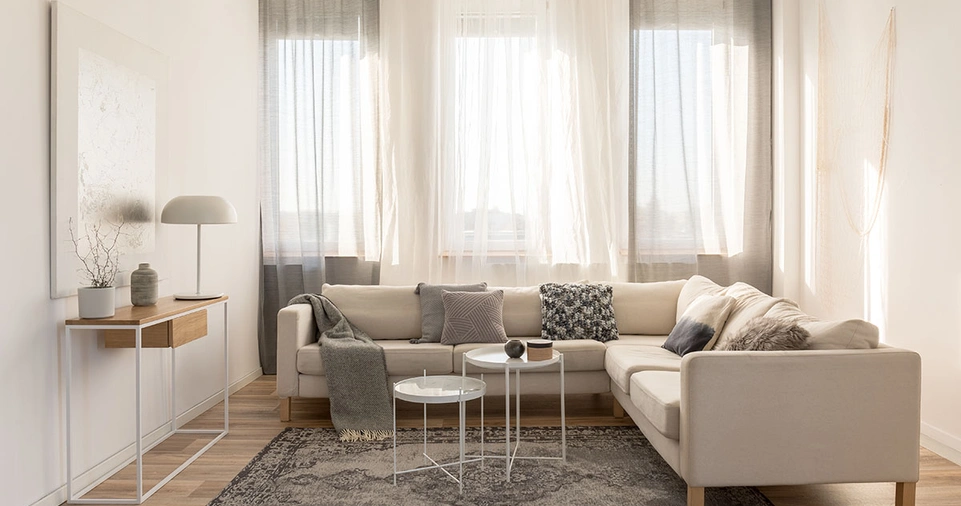Maximizing space in a small room can be challenging, but with the right design strategies, you can create the illusion of a larger, brighter space.
This article provides expert tips on how to make a small room appear more spacious and well-lit through smart design choices, furniture placement, color schemes, and lighting techniques.
We will also explore advanced storage solutions, color psychology, and practical decor hacks to enhance both aesthetics and functionality.
Optimize Color and Lighting
Choose Light and Neutral Colors
Light colors make a room appear larger by reflecting more light, creating an open and airy feel.
Opt for shades like white, beige, soft gray, or pastels for walls, ceilings, and furniture. Matte finishes can reduce glare and provide a soft, diffused glow.
The Psychology of Colors in Small Spaces
- White & Off-White: Enhances brightness and gives a clean, fresh look.
- Soft Blues & Greens: Create a calming, expansive effect.
- Light Pastels: Add warmth without overwhelming the space.
- Grays & Taupes: Provide sophistication while maintaining openness.
Use Proper Lighting
Lighting plays a crucial role in making a room look more open and inviting. Use multiple light sources, including ceiling lights, floor lamps, table lamps, and wall sconces, to eliminate dark corners and add depth.
Leverage Natural Light
- Use sheer curtains instead of heavy drapes.
- Keep windows clear of obstructions.
- Use mirrors to reflect natural light across the room.
| Lighting Tip | Effect |
|---|---|
| Layered lighting (ambient, task, accent) | Adds depth and reduces shadows |
| Warm LED bulbs | Enhances coziness without making the space look small |
| Mirror placement | Reflects light and creates an illusion of spaciousness |
ALSO READ: How to Design a Stunning Front Yard That Boosts Curb Appeal?
Strategic Furniture Placement

Choose Multi-Functional Furniture
Opt for furniture that serves multiple purposes, such as:
- A storage ottoman that doubles as a coffee table.
- A sofa bed for sleeping and seating.
- A foldable desk for work and dining.
- Nesting tables for flexibility.
- Murphy beds to save floor space.
Keep Furniture Proportional
Avoid oversized furniture that overpowers the space. Instead, select slim-profile and space-saving designs with exposed legs to maintain an open feel.
Arrange Furniture to Maximize Space
- Place larger pieces against walls to open up floor space.
- Leave pathways clear to allow easy movement.
- Use floating shelves to free up floor space.
- Opt for wall-mounted desks and foldable dining tables.
| Furniture Choice | Benefit |
|---|---|
| Multi-functional furniture | Maximizes space efficiency |
| Low-profile furniture | Keeps the room from feeling cluttered |
| Transparent or mirrored furniture | Creates an airy feel |
| Wall-mounted desks and fold-out tables | Frees up floor space |
Enhance Visual Space
Use Mirrors Strategically
Mirrors reflect light and create an illusion of extended space. Place mirrors:
- Opposite windows to maximize natural light reflection.
- Behind furniture to create depth.
- On closet doors to make the room feel expansive.
- Mirrored wall panels to visually double the space.
Choose Minimalist Decor
A clutter-free space feels larger and more open. Stick to:
- A simple color palette.
- A few statement pieces instead of multiple decorations.
- Hidden storage to keep surfaces clean.
Use Vertical Space
Tall bookcases, floor-to-ceiling curtains, and mounted shelves draw the eye upward, making the room seem taller.
| Design Trick | Effect |
|---|---|
| Floor-to-ceiling curtains | Creates the illusion of taller ceilings |
| Vertical shelving | Adds storage without taking up floor space |
| Large wall art instead of multiple small pieces | Reduces visual clutter |
ALSO READ: How to Select the Best Tech Gadgets for Outdoor Spaces?
Flooring and Rugs

Choose the Right Flooring
Light-colored flooring enhances spaciousness. Consider:
- Light wood or laminate.
- Large tiles with minimal grout lines.
- Continuous flooring across rooms to create flow.
- Diagonal or herringbone patterns to elongate the space visually.
Use Rugs Wisely
- Opt for large rugs to make the space feel expansive.
- Choose light colors with subtle patterns.
- Position rugs to define spaces without breaking up the flow.
- Avoid small, scattered rugs that can make the room feel cramped.
| Flooring Option | Benefits |
|---|---|
| Light wood flooring | Expands perceived space |
| Large tiles | Reduces visual breaks |
| Consistent flooring across rooms | Enhances flow and openness |
| Diagonal/herringbone patterns | Adds visual interest and depth |
Smart Storage Solutions
Use Built-In and Hidden Storage
To keep a small room tidy, use built-in storage solutions like:
- Under-bed storage drawers.
- Wall-mounted cabinets.
- Foldable or extendable furniture with hidden compartments.
- Over-the-door organizers and hanging racks.
Declutter Regularly
Keep only essential items and store the rest away. Use decorative baskets, bins, and organizers to maintain a neat look.
Smart Closet Organization
- Use space-saving hangers.
- Install vertical dividers.
- Use clear storage bins for easy visibility.
- Maximize the back of doors with storage hooks.
| Storage Tip | Effect |
|---|---|
| Hidden storage under furniture | Keeps items out of sight, reducing clutter |
| Floating shelves | Saves floor space while providing storage |
| Multipurpose furniture | Maximizes utility in a small room |
| Over-the-door organizers | Utilizes overlooked storage areas |
Accessorizing for a Bigger and Brighter Look

Use Glass and Reflective Surfaces
- Glass tables, acrylic chairs, and mirrored decor enhance spaciousness.
- Metallic or glossy finishes help bounce light around the room.
Stick to a Cohesive Color Palette
- Avoid too many contrasting colors, which can make the space look busy.
- Use varying shades of the same color to add depth without clutter.
Incorporate Plants
- Small potted plants add freshness without overwhelming the space.
- Hanging plants or vertical gardens save floor space.
- Opt for low-maintenance greenery like succulents or ferns.
| Accessory | Impact |
|---|---|
| Glass and acrylic furniture | Creates an airy, open feel |
| Light-colored textiles | Enhances brightness and softness |
| Minimalist artwork | Reduces clutter while adding personality |
| Metallic decor elements | Reflects light and enhances openness |
Conclusion
Making a small room look bigger and brighter requires strategic choices in color, lighting, furniture placement, and decor.
By using light tones, maximizing natural and artificial lighting, choosing multi-functional furniture, and reducing clutter, you can create an inviting and spacious atmosphere.
Small changes, such as adding mirrors, vertical elements, and smart storage solutions, can make a significant difference in transforming a compact space into an open and airy retreat.






